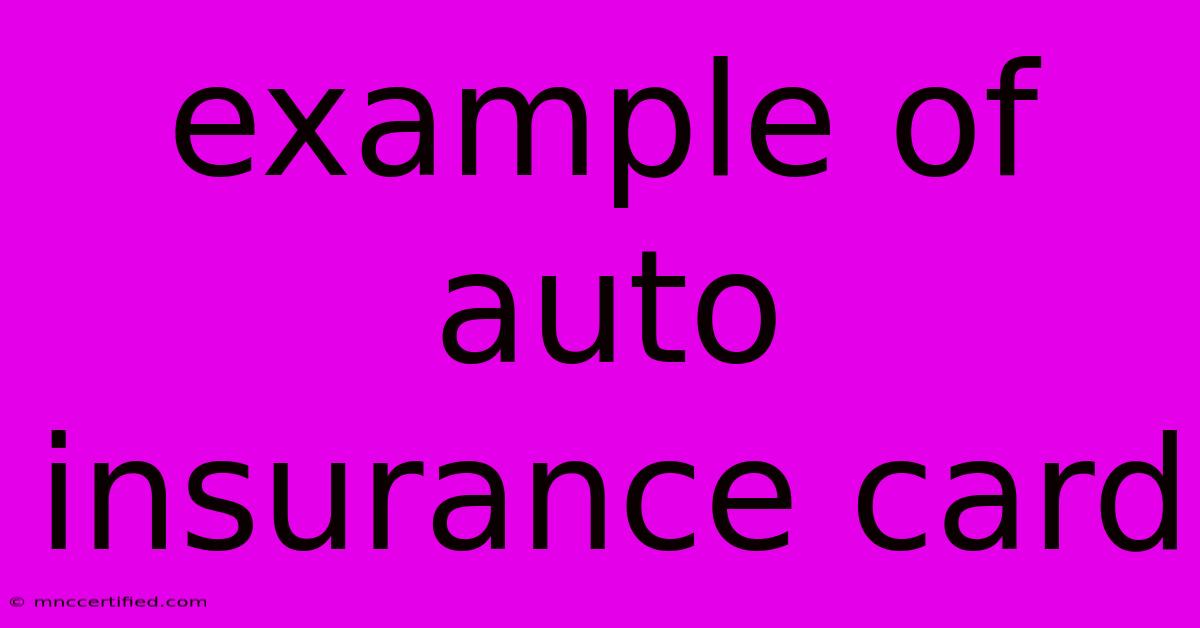Example Of Auto Insurance Card

Table of Contents
Example of Auto Insurance Card: What to Look For & Why It's Crucial
Having the right auto insurance is essential for responsible driving. But beyond just having coverage, understanding your insurance card and knowing what information it contains is equally important. This article provides examples of what an auto insurance card might look like, explains the key information to look for, and highlights why carrying this crucial document is vital.
What Does an Auto Insurance Card Look like?
There's no single, universal design for an auto insurance card. The appearance varies significantly depending on your insurance provider. However, they all share core information. Think of it as a concise summary of your policy, designed for quick reference. Instead of a single "example," let's break down the common elements you'll find on most cards:
Key Information on Your Auto Insurance Card:
- Your Name and Address: This is the policyholder's information – the person named on the insurance policy.
- Policy Number: A unique identifier for your specific insurance policy. Keep this number handy for contacting your insurer.
- Vehicle Identification Number (VIN): This 17-character alphanumeric code uniquely identifies your vehicle. It's crucial for verifying your coverage.
- Dates of Coverage: Clearly indicates the period your insurance is valid. Note the start and end dates to avoid lapses in coverage.
- Coverage Details (Type and Limits): This section summarizes the types of coverage you have (e.g., liability, collision, comprehensive) and the limits for each. Liability limits typically show amounts like 25/50/25, representing bodily injury coverage per person, bodily injury coverage per accident, and property damage liability.
- Insurance Company Information: This includes the insurer's name, logo, contact information (phone number, website), and sometimes the agent's details.
- State of Issuance: Your insurance card will reflect the state where the policy was issued.
Example Snippet (Illustrative – Not a Real Policy):
Imagine a simplified version:
Acme Insurance Company
Policy Number: 1234567890
Policyholder: John Doe
Address: 123 Main St, Anytown, CA
Vehicle VIN: 1G87654321ABCDEFG
Coverage: Liability 25/50/25, Collision, Comprehensive
Effective Dates: 01/01/2024 - 12/31/2024
Important Note: This is a highly simplified example. Your actual card will be more detailed and likely include additional information.
Why is Carrying Your Auto Insurance Card Important?
Carrying a valid auto insurance card is mandatory in most states. Failure to do so can lead to fines and other penalties. Here's why it's crucial:
- Proof of Insurance: Police officers and other authorities will often request to see your proof of insurance during traffic stops.
- Accident Scenarios: In the event of a car accident, providing your insurance card quickly and efficiently helps expedite the claims process.
- Rental Car Requirements: Some rental car companies require you to present proof of insurance before renting a vehicle.
- Legal Compliance: Carrying your card demonstrates your compliance with state laws regarding auto insurance.
Digital vs. Physical Auto Insurance Cards:
Many insurers now offer digital versions of your insurance card through their mobile apps. While convenient, it's still highly recommended to have a physical copy readily available in your car, especially considering potential technology failures or connectivity issues.
What to Do if Your Auto Insurance Card is Lost or Stolen:
Contact your insurance provider immediately to report the loss and request a replacement. They will guide you through the process of obtaining a new card.
Conclusion:
Your auto insurance card is more than just a piece of paper; it's a crucial document that proves your compliance with the law and safeguards you in various situations. Understanding the information it contains and keeping it readily available can save you significant hassle and potential legal repercussions. Remember to always check the expiry date and update your information with your insurance provider as needed.

Thank you for visiting our website wich cover about Example Of Auto Insurance Card. We hope the information provided has been useful to you. Feel free to contact us if you have any questions or need further assistance. See you next time and dont miss to bookmark.
Featured Posts
-
Wednesdays Push Rohls Reveal
Nov 27, 2024
-
Bonnie Blues This Morning Outburst
Nov 27, 2024
-
Almanac Key Dates November 27 2024
Nov 27, 2024
-
Is Ptosis Covered By Insurance
Nov 27, 2024
-
Today In History Daily Events
Nov 27, 2024